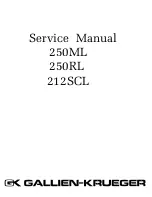
Caution Note:
If the second stage is leaking even slightly, IP will be affected. If the second stage is
leaking, turn the adjustment knob to stop it or use a second stage that is not leaking
through when paired with the first stage.
(4) The standard operating range for the system is with an IP of 135 PSI. Ideally, the system is operating at
135 PSI +/ 5 PSI and show no signs of “creep” or instability at 3000 PSI.
Caution Note:
“Creep” will show as the IP steadily increasing while the regulator is not in use. Normally
the IP will drop 510 PSI during a breath or purge and then return to its setting. It should
not return to the setting and keep increasing. This would indicate a problem with the
highpressure seat, Piston, or sealing orings.
(5) If the system shows no sign of creep or IP instability, it is generally not necessary to rebuild the 1
st
stage
with some exceptions.
Caution Note:
If the unit shows signs of internal corrosion or the filter shows evidence of contamination,
the unit must be rebuilt! Regardless of the Intermediate Pressure.
(6) The regulator will require rebuilding if small bubbles are leaking from between the turret retainer and
main body, from under the rubber cap, or out of the highpressure seat retainer. Knowledge of flooding of
the first stage will also require the unit to be rebuilt. Freshwater contains dissolved minerals and other
materials that, due to internal corrosion over time, may cause the regulator to malfunction.
(7) After the IP has been checked, hoses and regulator body inspected, and SPG evaluated, the service of the
1
st
stage can take place if it is determined that service is necessary.











































